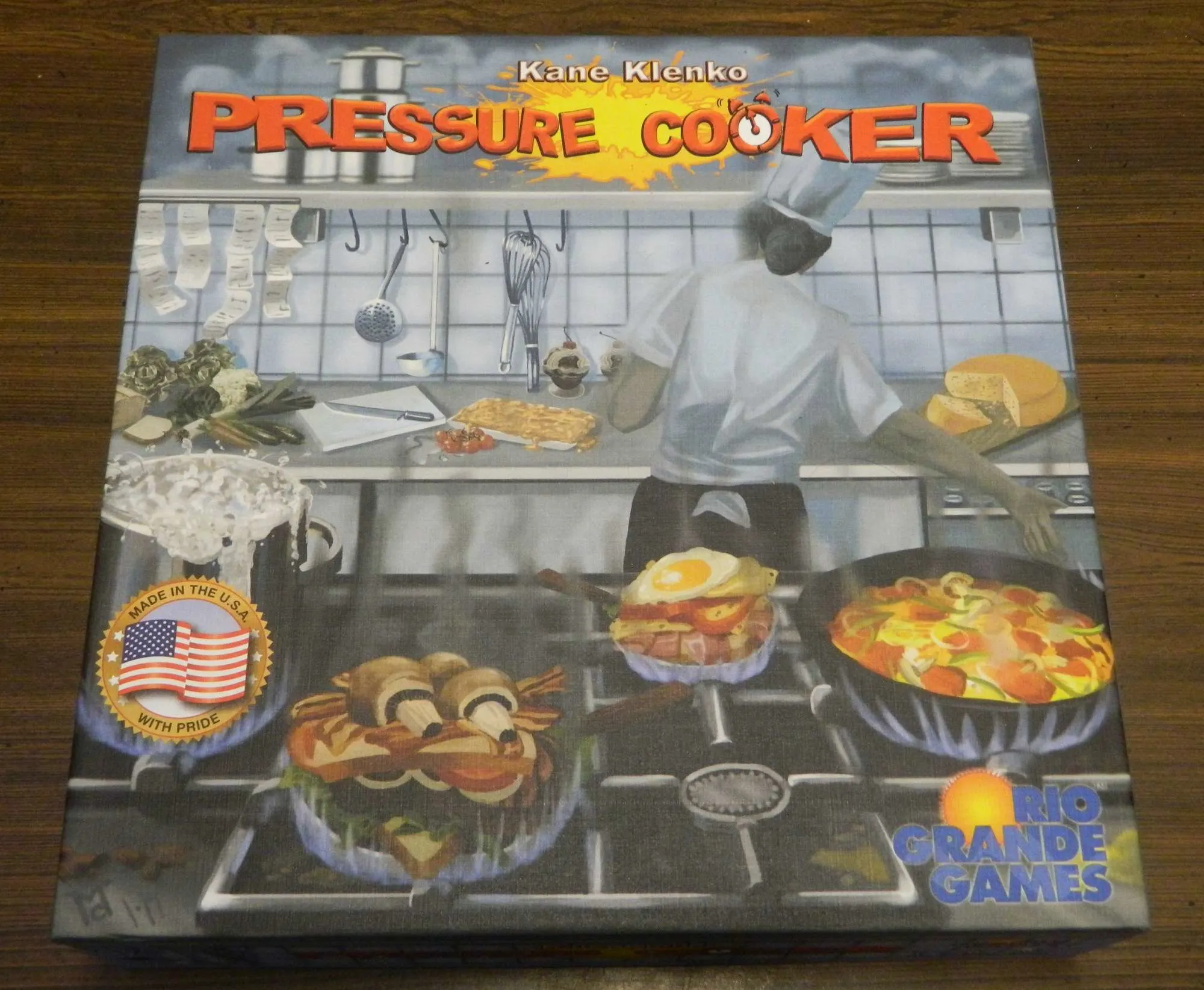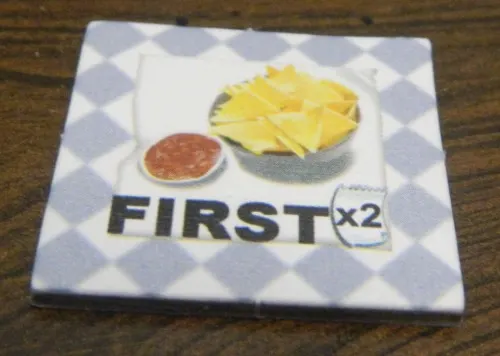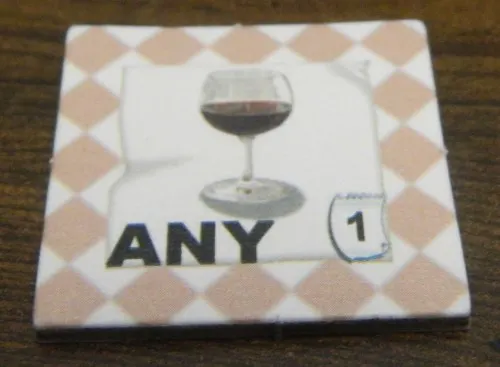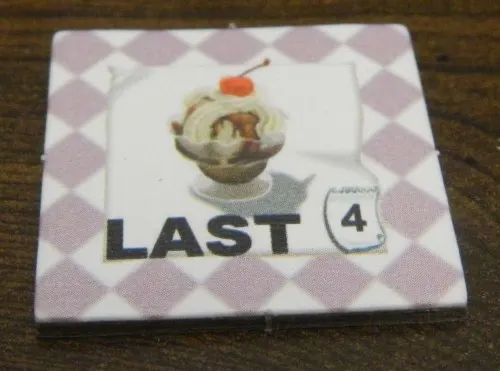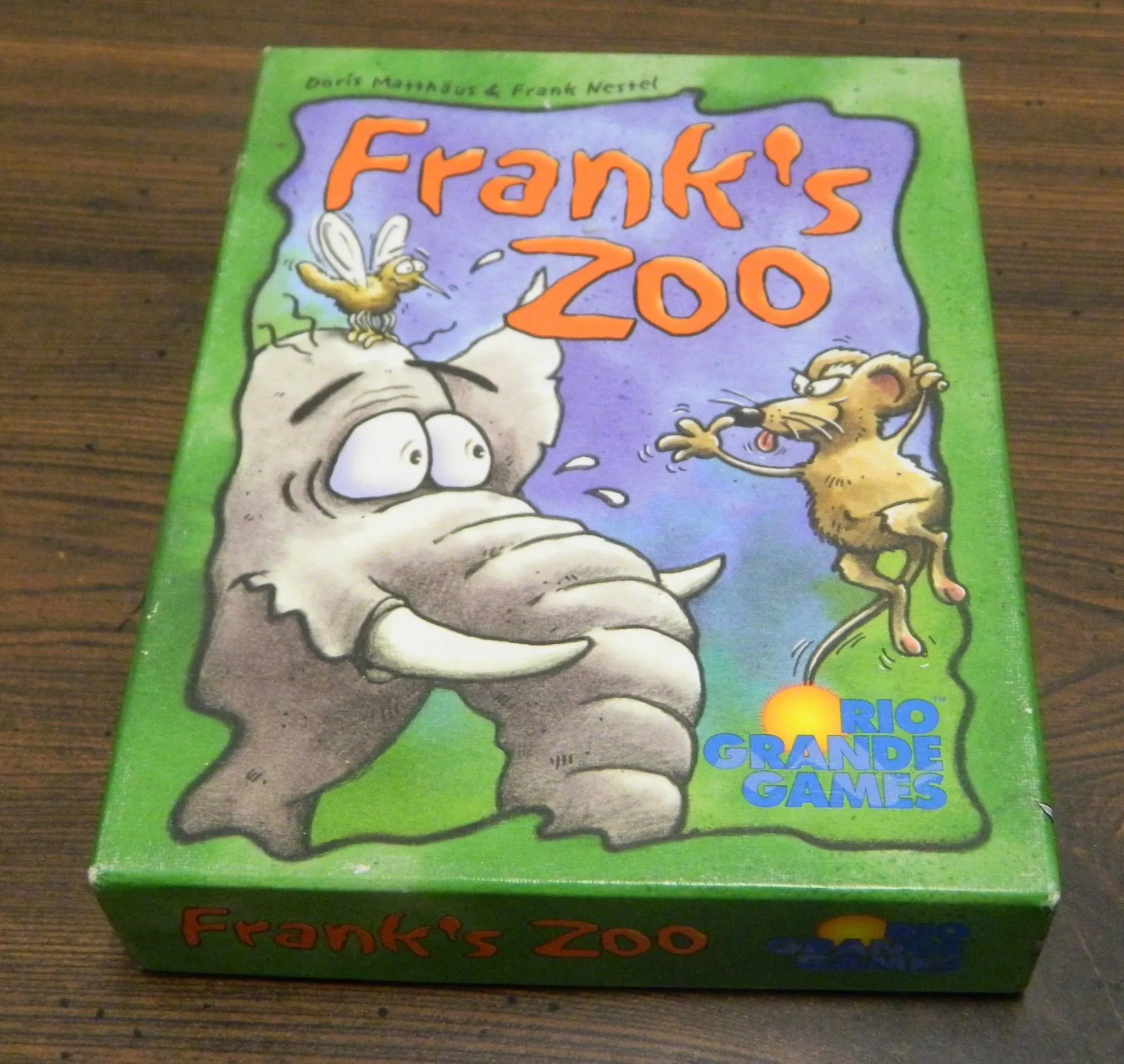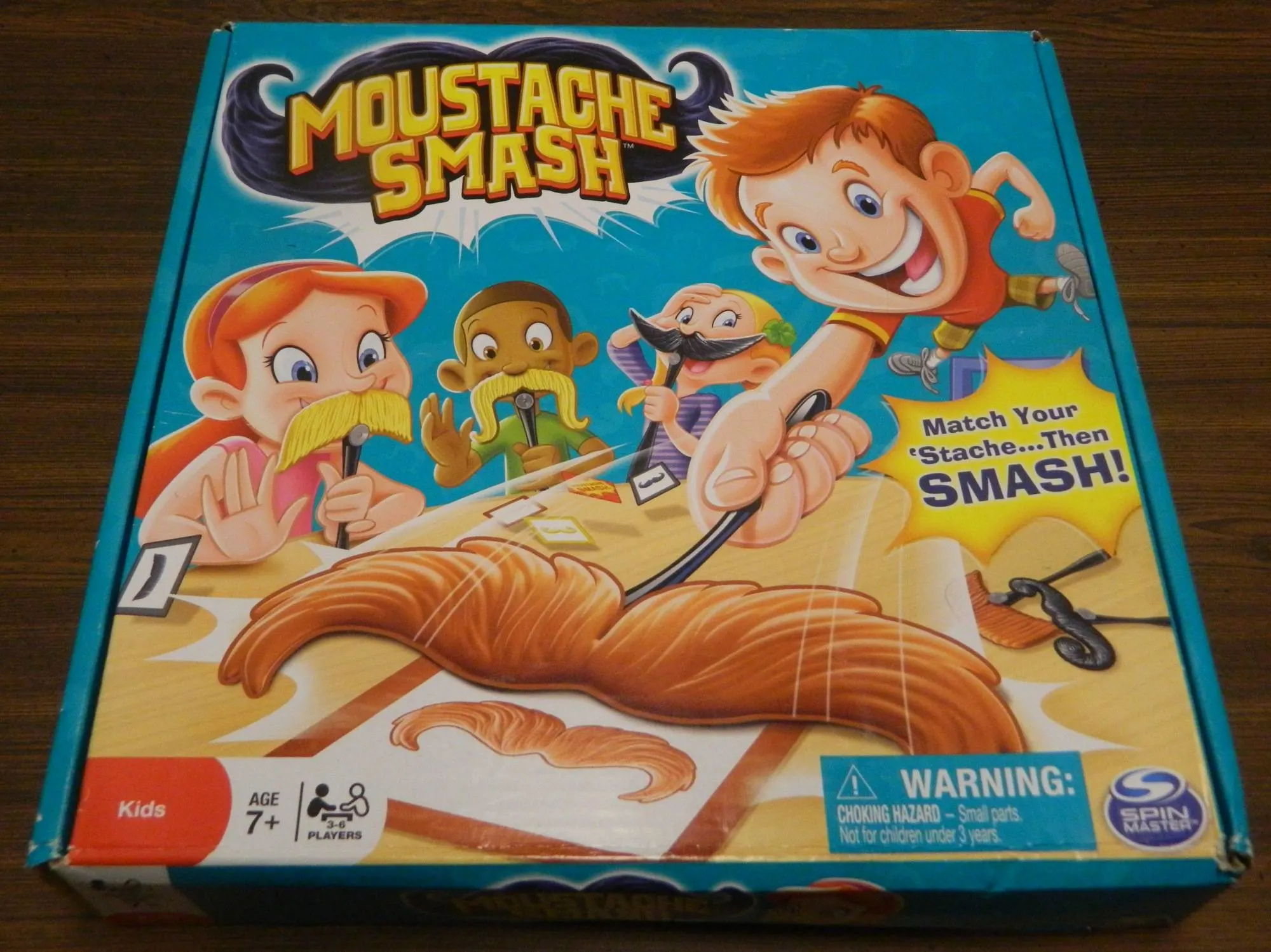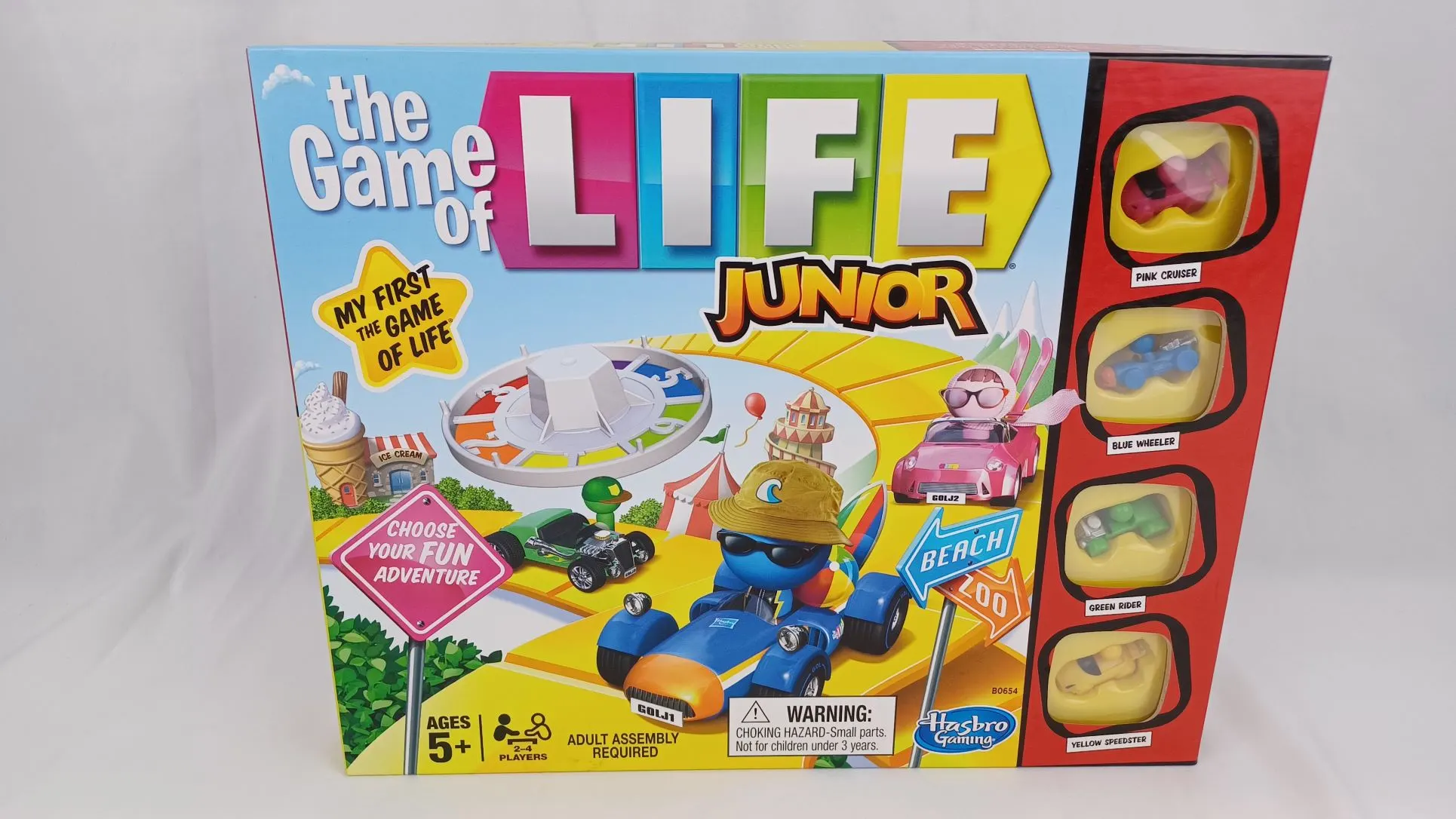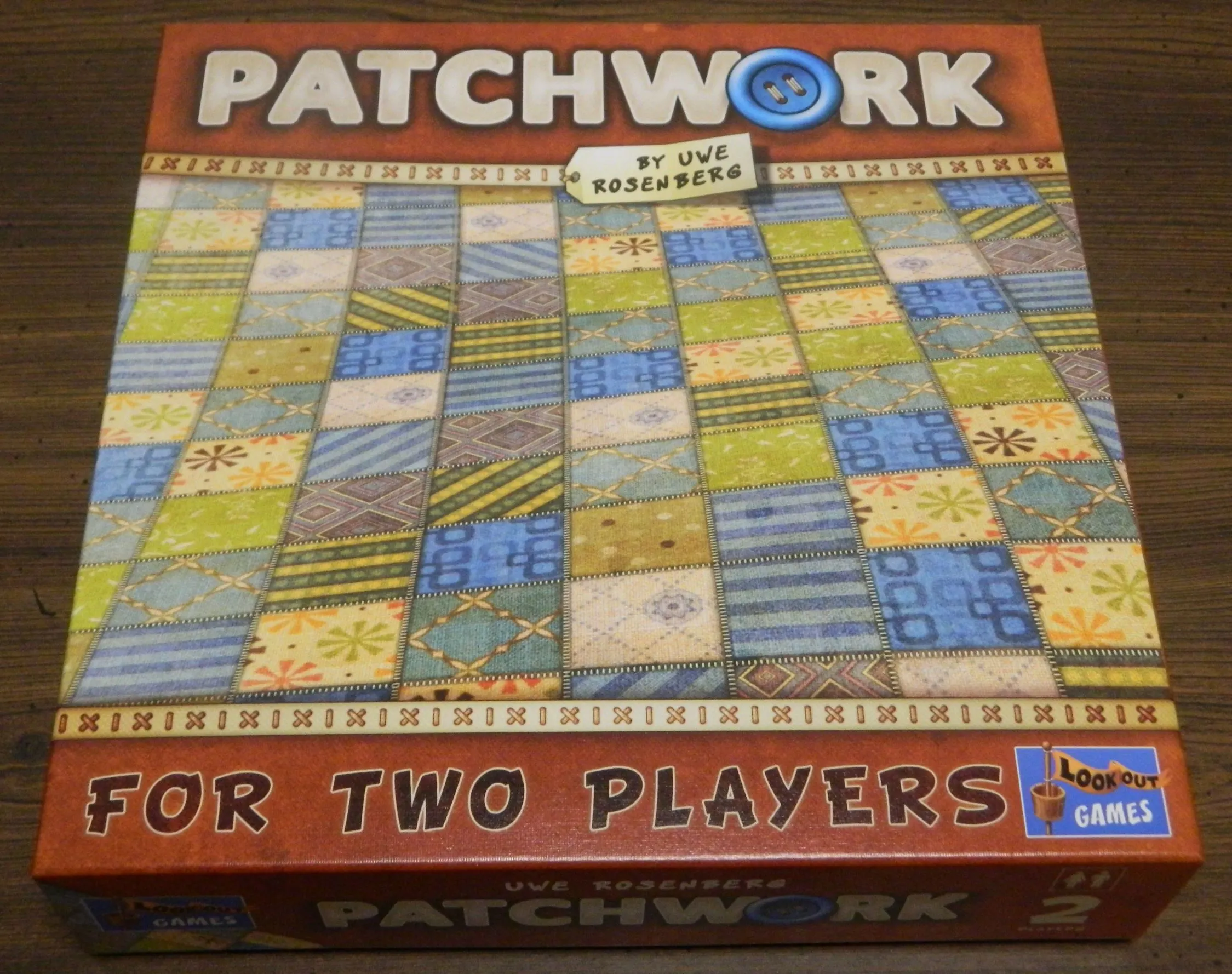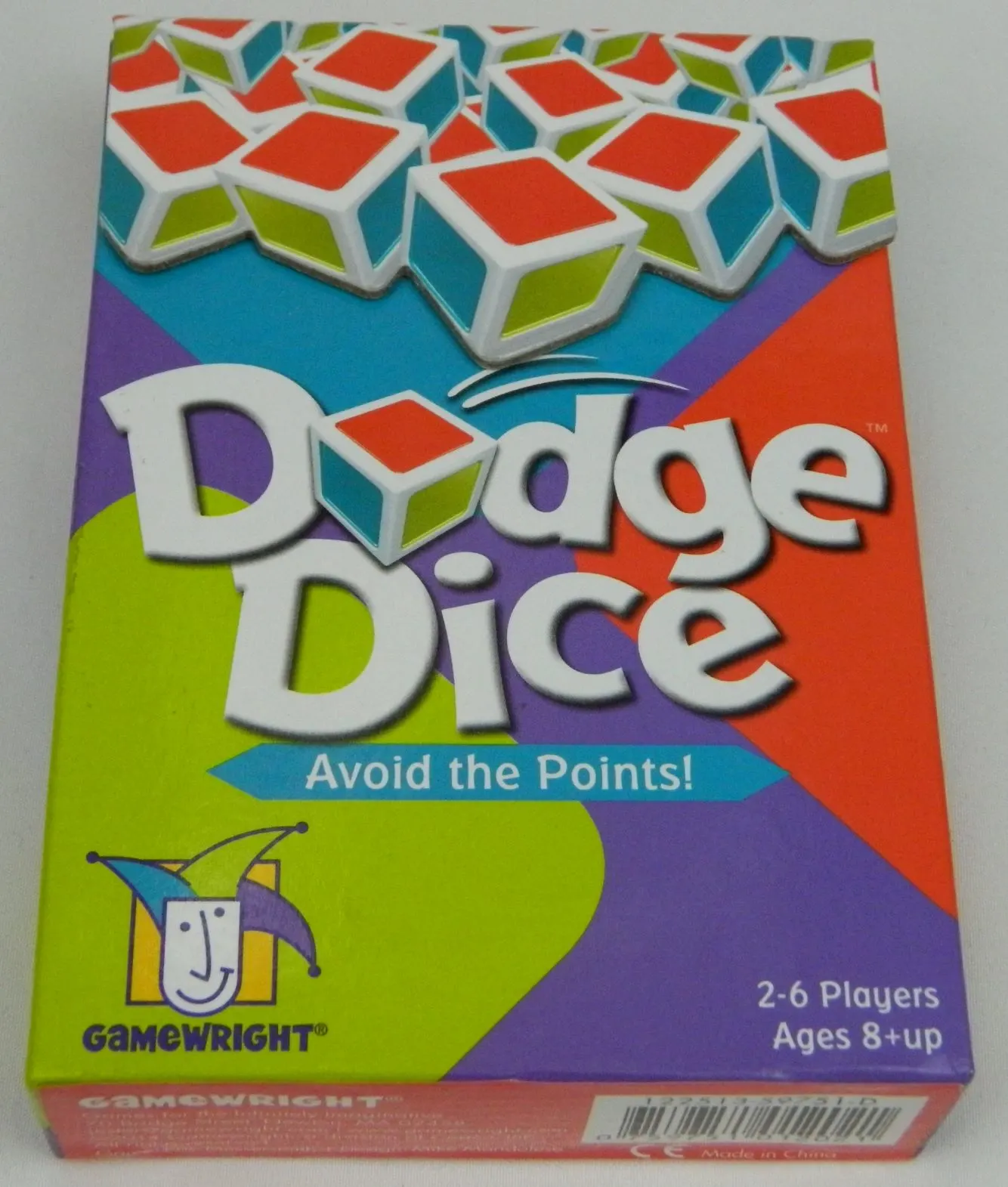How to Play
Objective
At the end of three rounds, do the best job managing orders from the different tables to score the most points.
Setup
Each player takes a kitchen board, cookbook board, 2 appetizer tiles and 20 order up tokens of their color. If less than four players are playing the game, place the extras of the above components back in the box. Players set all of the dials on their kitchen boards to zero.
Place the table boards and the timer so everyone can reach them. If this is a two or three player game don’t put out the blue table card. Place the sink tile next to the table cards. Shuffle all of the ingredient tiles face down in the middle of the table forming a pile to draw tiles from.
To set up the table boards players shuffle the order cards. They then start filling each table with cards starting with the #1 space on the table card. Players draw a second card and place it on the #2 space. If the numbers on the top plate of both cards drawn add up to less than sixteen, a third card is added to the table. If they total more than sixteen, a third card is not placed on the table. This is done for all of the tables in play. This process is done at the beginning of every round.
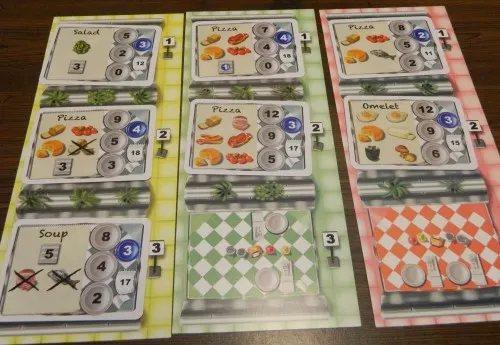
Here is the menu set up for a three player game. The green and red tables only have two cards since the first two cards top point value totals more than 16 points.
Cooking
The main goal in Pressure Cooker is to make the orders laid out on the table cards. To make the food, players need to draw tiles from the pile to get the necessary ingredients for the order. All players start drawing tiles at the same time without taking turns. While drawing tiles the following rules must be followed:
- You can only use one hand to draw tiles and can only have one tile in your hand at a time.
- After grabbing a tile you have to bring it back to your board before deciding what you want to do with it.
- If you don’t want the ingredient you must put it back into the pile face up so all of the other players can see what it is.
- If you want to keep an ingredient you place it on your kitchen board in the position that corresponds to the color and number of the food item that you want to apply the ingredient to. Once a tile is placed it cannot be removed or moved to a different spot on the kitchen board. You can pick up the tiles though in order to see which ingredients you have placed in a pile but the tiles must be put back in the order that they were originally placed.
- If a player wants one of the tiles that have been turned face up in the pile, they may freely take it if they have no other tiles currently in their hand.
- A player may not add any ingredients to an order that they have already completed.
A player can work on multiple orders at the same time and don’t have to complete them in any particular order. In order to complete an order the player has to place all of the necessary ingredient tiles (ingredients pictured on the order card) on the corresponding spot on their kitchen board. Some of the order cards have some special requirements that need to be met in order to complete an order.
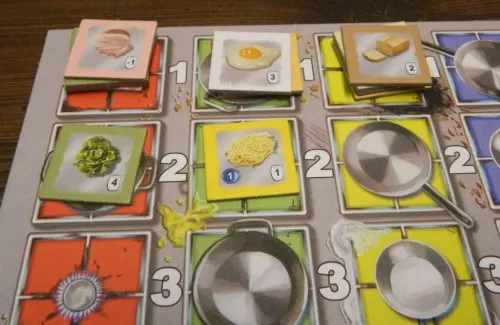
This player is currently working on multiple orders at the same time. Each new tile for an order is placed on top of the tiles already placed into that order.
If an ingredient is crossed out on a card, that ingredient cannot be added to the order.
If there is a number inside a cookbook a player needs to add additional ingredients equal to the number on the card to the order. Additional items that can be added to the order can be found by referencing the cookbook card.
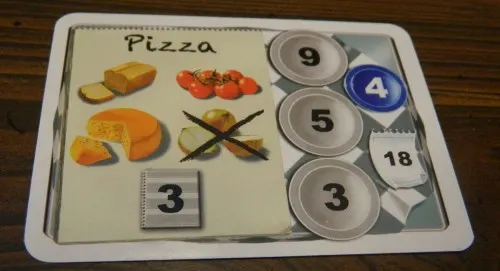
This order of pizza has two special conditions. The order cannot include onions as indicated by the onions that are crossed off. The order also needs three additional ingredients not pictured on the card. Ingredients that can be added to the pizza are found on the cookbook card.
If there is a blue circled number inside a cookbook, players score that many bonus points for every additional ingredient added to the order. The additional ingredients are optional so the order can be completed without any optional ingredients being added to the order.
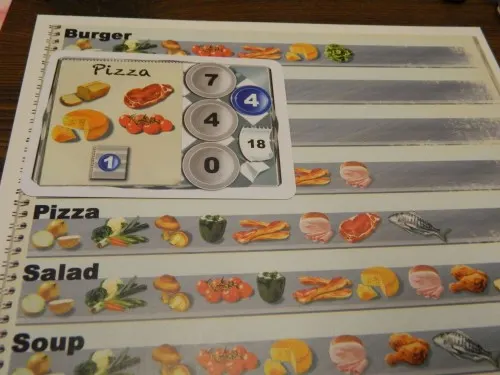
To complete this pizza order the player needs to add bread, meat, cheese and tomatoes. Any additional ingredients listed on the cookbook card that the player adds to the order adds one additional point to the value of the completed order.
When a player thinks they have all of the required ingredients for an order, they take two of their order up tokens. They place one on the stack of tiles to indicate they completed that order and they place the other order up token on the corresponding order card that they completed. The first player to finish the order places their order up token on the top plate. The second player to complete the order places it on the second plate and so on. When a player completes an order they yell out “Order Up” to indicate to the other players that they completed one of the orders.
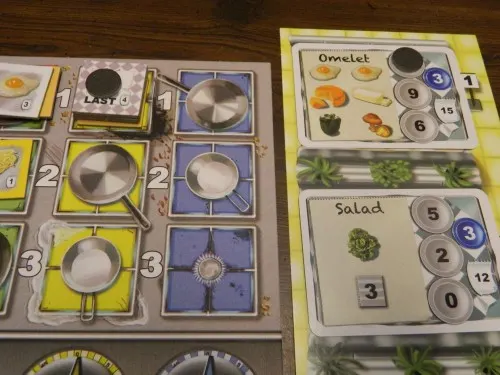
The player pictured thinks they completed their omelet order. They place one of their order up tokens on the stack of tiles used to complete the order and place another order up token on the top available plate on the order card.
Food Quality
In addition to completing orders players can score additional points for producing a quality meal. Each order card has two numbers along the right side of the card. The top number in the blue circle is the quality bonus for the order and the bottom number is the quality minimum. The quality bonus is the bonus a player “could” receive for providing a quality order while the minimum shows how high the quality of the order has to be for a player to be eligible for the quality bonus.
Every ingredient in the game has a quality range that varies from -1 to 4. The quality number for an ingredient is the number in the bottom right corner of the tile (the black number in front of the piece of paper).

Here are three different ingredient tiles. From left to right they are worth -1, 3 and 1 quality. The last tile is also worth one bonus point if used in an order.
During scoring each player adds up all of the quality numbers from the ingredients used to create an order. After adding in any bonuses, if the quality total is higher than the quality minimum the player has a chance at earning the quality bonus. Whichever player has the highest quality for each order gets the quality bonus. If none of the players reached the quality minimum though, no player receives the quality bonus. If there is a tie for quality the following rules are used:
- If two or more players have the same quality they share the points with any remainder going to the player who finished the order first.
- If the order does not have enough points to give each tied player at least one point, no one gets any quality bonus points for the order.
- In a two player game if there is a tie the entire quality bonus goes to the player who finished the order first.
Special Ingredient Tiles
Pressure Cooker has three special appetizer tiles that can be used to give additional bonuses to players that use them.
Appetizers: To start each round each player gets two appetizer tiles. A player can choose not to use these tiles if they don’t want to. If a player wants to use them though the appetizer tiles need to be the first tile played for any given order and only one appetizer can be played for each order. If they are not the first tile played for a given order they offer no potential bonus to the player and result in a penalty. If they are the first tile played though, they double the quality score for all of the tiles included in the order that they were placed in. If a player doesn’t finish the order that they placed an appetizer in though they will face a point penalty which is discussed in the scoring section.
Drinks: Drinks can be added to any incomplete order at any time. Each drink increases the quality of the order by one. A player can add as many drinks to an order as they want.
Desserts: Only one dessert can be added to each order and it has to be the last tile added to the order. Desserts add either three or four quality points to the order that they were added to.
Ending a Round
Any player can choose to end a round when they have reached the minimum requirements for the round. When a player decides to end a round they yell out “Pressure Cooker” and they flip over the timer. The player that ended the round can no longer make any moves but the other players can continue adding tiles to their orders until the timer runs out. When the timer runs out all players must stop adding tiles and the game proceeds to the scoring phase. The minimum requirements to end each round are as follows:
- Round 1: A player must have completed at least three orders.
- Round 2: A player must have completed at least four orders.
- Round 3: A player must have completed at least five orders.
Scoring
Scoring is completed at the end of all three rounds. Scoring starts with one table with each player scoring the first order, then the second order and then possibly the third order (if there was a third order) on that table. When calculating the score players add the points earned to their corresponding colored dial that matches the table that was being scored.
When scoring an order each player’s order is examined to make sure that they added all of the necessary ingredients to the order. An order is considered complete if the player didn’t miss any ingredients, did not add any ingredients not allowed or required for the order, and special ingredient tiles were played in the proper place.
If a player correctly completed an order they score the number of points indicated on the plate that they put their order up token on and score any bonus points indicated on the ingredients that they used in the order (numbers inside blue circles on the ingredient tiles). If a player messed up which made them make an incomplete order, their order up token is removed from the order card and any order up tokens located below the removed token are pushed up one space.
If a player made a mistake they will be accessed a penalty.
- Appetizer Penalty: If the appetizer tile that was used was not the first tile played for an order or it was played on an order that wasn’t completed, the player loses points equal to the quality bonus for the order that it was placed on. These points are subtracted from the dial of the color that is currently being scored.
- Incomplete Orders: If a player didn’t complete an order but didn’t add any incorrect tiles to it, they receive no penalty and they put all of the tiles used back into the pile in the center of the table. They score no points for the order though.
- Incorrect Tiles: If a player adds an incorrect tile to an order or duplicates an ingredient that the recipe didn’t require, every other player scores two bonus points for every incorrect tile. These points can be applied to any of the color dials.
- Duplicate Tiles in a Completed Order: If a player added duplicate tiles to an order but it was otherwise complete, the players still scores points for the order but they must discard the duplicate tile that has the higher quality rating. All of the other players also score two bonus points that they can apply to any dial.
After players have added their points scored for the order, bonus points for quality are added if applicable (see Food Quality section).
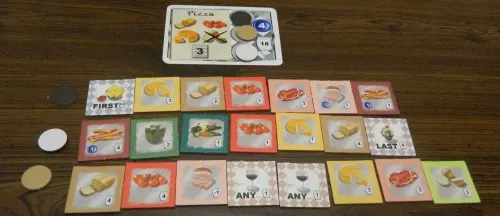
The black player was the first player to complete the pizza order followed by the beige player, and finally the white player. The black and white player successfully completed their order but the beige player accidentally added onions to their order which was incorrect. Their order is therefore incorrect so the white token would be moved up one space on the order card, and all of the other players get two points due to beige’s mistake.
The black player would get 11 points for their order (nine for finishing first and two bonus points from the ingredient tiles). The white player would score six points (five from completing the order and another point for their bacon ingredient).
For the quality bonus the black player’s order has a quality of 22 while the white player’s order has a quality of 17. The white player doesn’t have a high enough quality score to even quality for the quality bonus. The black player would get the four point quality bonus.
All completed order up tokens from the order card are put in the sink after the orders have been scored. Once all orders are scored two bonuses are given out.
The player that turned over the timer gets eight bonus points for being the fastest cook as long as they met the requirements to end the round. If one of their orders were disqualified which means they didn’t have enough completed orders to end the round, they lose five points. These points can be added/subtracted from any dial.
Players then count up the number of order up tokens in the sink. These tokens indicate how many orders a player completed during the round. The player that completed the most orders in the round gets three bonus points that can be applied to any dial. If two or more players tie for the most orders completed, no one scores these bonus points.
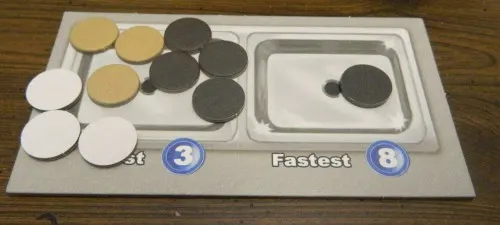
At the end of the round the player using the black token was the player who turned over the timer so they get eight bonus points. The black player also completed four orders while the other players only completed three orders so they get the three bonus points for completing the most orders.
If a player’s scoring dial goes past fifty points they take a 50+ tile and continue turning the dial to indicate the points they have above fifty points.
The round is concluded with everyone taking back their order up tokens, and their two appetizer tiles. All other ingredient tiles are placed face down in the pile and the pile is shuffled. All order cards are discarded and new order cards are put out if this was the end of the first or second round (check out the Setup section for details on how to put out order cards). If this was the third round, the game ends.
End of Game
After the third round ends, final scores are taken. Players look at all of their dials to figure out which one has their lowest score. This is the player’s final score for the game. Players compare their scores and whoever has the highest final score wins the game. If two or more players have the same score the tie is broken by whose second lowest score is the highest. If that doesn’t break the tie players look at their third lowest score and so on.
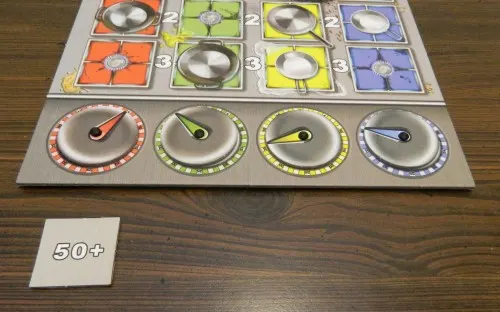
Looking at this player’s dials, they scored the least points in yellow. Their yellow score is their final score in the game and is used to determine whether the player won the game.
Review
I am a fan of speed related games where all of the players play at the same time and all of the players are competing to complete some objectives. Most of these type of games are card games so I was intrigued when I saw Pressure Cooker since it was a speed game that utilized tiles, various different strategies, and combined it together with a cooking theme. While I am far from a chef I was really excited to try the game because it sounded like a fun and unique experience that I hadn’t experienced in other board games. While Pressure Cooker is not a perfect game I have to say that for the most part it lived up to my expectations.
While I have played many different speed games, I don’t think I have ever played a game like Pressure Cooker before. Basically the game adds a bunch of different mechanics together that I have never seen combined before. A lot of people say that the game plays like Galaxy Trucker but since I haven’t been able to play Galaxy Trucker before I can’t verify whether that is accurate or not.
When I first started looking through the rules I started to worry that the game was going to be more complicated than it had to be. The rules take up quite a few pages and there are quite a few different mechanics in the game. If you are expecting this to be light on the difficulty side you will be surprised since the game is moderately difficult at least when you first start playing the game. You have to keep track of quite a few things at the same time. It takes a couple rounds to fully understand what you are supposed to be doing but like most games it becomes pretty easy once you figure out what you are supposed to do.
Before playing the game I was expecting it mostly to be a speed game where quickly drawing tiles and finding the ingredients you need being key to winning the game. While this is a key component to the game, there is a lot more to the game. Instead of blindly grabbing tiles there is actually a lot you have to think about. You have to reference different charts and make sure you are adding the right ingredients to the right orders. A player that hates speed games probably won’t like Pressure Cooker since you still need to play the game quickly. It is not like other speed games where you are constantly doing things with no breaks in game play. The game plays at a quick but calculated pace since you need to slow down the action to make sure you aren’t making mistakes.
There are three main strategies that you can pursue in Pressure Cooker.
You can take the speed route by completing orders really quickly and flipping over the timer. If you are able to flip over the timer you get the bonus for fastest cook. By going quickly you also will likely be the first or second player to complete every order which means you will get a lot of points for each order. Flipping over the timer also limits how much time the other players will have to complete orders. The speed route increases your chances for a mistake though and if you flip over the timer you probably won’t complete as many orders as the other players.
The second strategy involves quality over speed. With this strategy you try to create orders that have high quality scores. You will likely get the quality bonuses for the orders that you complete which can add up. Looking for quality components takes time though so you will unlikely finish first and you might not finish as many orders as the other players do.
The final strategy is to go for quantity over quality and speed. This is actually the strategy I employed in the game. Basically I tried to just complete as many orders as I could. Quality really didn’t matter since I pretty much just took any ingredient that I needed without really even looking at the quality score. Basically with this strategy I just wanted to complete as many orders as possible since that would give me more opportunities to score points. I wouldn’t score the most points for any given order but I would score points for most of the orders. The points really add up if you score points from every single order and it all but guarantees that you will get the bonus for completing the most orders every round.
In the game I played I ended up winning the game with the quantity strategy but I honestly believe each strategy has merit in the game and you could even blend the strategies together. I really like games that give players multiple different ways to win since it lets players play the game how they want and presents a lot of replay value since players can adopt different strategies every time they play the game.
One interesting mechanic in the game is the fact that the game forces you to spread your efforts to all of the different tables/colors. While you would want to just maximize your score in every color, when you get to the last round you really need to focus on the colors that you have scored the least amount of points in. While you can score a bunch of points in one color you are just wasting your time if you ignore one of the colors since your score is only based on your lowest score. This means that you need to think strategically about which orders you try to complete making sure that you complete orders in all of the colors. While I actually like this rule I wonder how the game would play with a rule where you just have one score total for all of the different colors.
Overall I had a lot of fun with Pressure Cooker and it is a game that I plan on keeping in my collection. It is an interesting combination of so many different mechanics that I don’t really have any other games in my collection that play like it. While I really liked the game it is not the type of game that I would play all of the time though since if you played the game constantly you probably would tire of it pretty quickly. It works better as a game that you would play every so often.
While I really liked Pressure Cooker I did have a couple complaints with the game.
While the scoring in the game is actually pretty simple once you get used to it, it does take longer than it should. If a round is quick you might end up spending more time scoring a round than playing it. The problem with the scoring is that there is just so much you have to do just to score one round. Each round has at least six different orders to score and each order takes a while to score especially when you need to figure out the quality score for every order. While the time needed to score each round doesn’t ruin the game it does kind of kill the game’s momentum.
For the most part I really like the components of Pressure Cooker. Like most Rio Grande games the components are well done. I thought the artwork is good and the game is well designed which makes it easy to quickly find any information that you need for the game. I also like that the game comes with plenty of tiles and there is a lot of variety in the order cards so every game should feel differently.
The components are really good except for the scoring dials. I love the idea behind the dials keeping track of the score since they work perfectly for the theme. Unfortunately our group never used them to keep score because they are too imprecise to use for a key component like the score of the game. The problem with the dials is that they move too easily. When you are quickly moving your arms around picking up and placing tiles it is almost guaranteed that at least one players’ dial will be turned at one point changing their score. Since we knew this was a forgone conclusion, our group decided to just keep track of the score on a piece of paper. I don’t know why Rio Grande didn’t either include dials that didn’t turn so easily or found a different way to keep track of players’ scores.
Final Verdict
I had a lot of fun with Pressure Cooker. The main mechanic of making the orders is simple but has quite a bit of strategy behind it since you have a lot of different things that you have to consider at any given time. The game is a speed game but you do a lot of thinking in the game as well. Not being much of a cook myself I didn’t think I would ever like a game based on the theme of cooking but I really liked Pressure Cooker. I wouldn’t play the game all the time but I plan on keeping Pressure Cooker in my collection.
If you like speed games or like the cooking theme I think you will really like Pressure Cooker. If you don’t like speed games though Pressure Cooker might not be for you.
If you would like to purchase Pressure Cooker you can purchase it on Amazon here.

